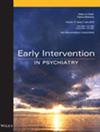The role of cognitive disengagement syndrome in non-suicidal self-injury among adolescents with attention deficit hyperactivity disorder
Abstract
Aims
We aimed to investigate the relationship between Cognitive Disengagement Syndrome (CDS) and non-suicidal self injury (NSSI) in adolescents with attention deficit hyperactivity disorder (ADHD).
Methods
A semi-structured psychiatric interview and an NSSI screening questionnaire were conducted. Questionnaires assessing CDS (with daydreamer, sleepy, and slow subdimensions), depression, anxiety, self-esteem, emotion regulation, coping strategies, and loneliness were administered.
Results
Among 104 participants (n: 63, 60.6% girls), the combined type of ADHD was the most common (66.3%), and 35 adolescents (27 girls) were in the NSSI+ group. Although only depression and ADHD were found to be predictors of NSSI in ADHD, CDS was associated with many risk factors of NSSI in ADHD: depression, anxiety, emotion dysregulation, low self-esteem, and emotion-oriented coping ways. After controlling for the effects of cognitive problems/inattentiveness, depression, and anxiety, CDS still correlated with low self-esteem and emotion dysregulation. The daydreamer and slow sub-dimensions of CSD differed between NSSI+ and NSSI- groups, while sleepy did not.
Conclusions
CDS is associated with several relevant factors, indirectly relating it to self-harm in ADHD. CDS increases the vulnerability to mental health changes that could lead to NSSI in adolescence with ADHD.

 求助内容:
求助内容: 应助结果提醒方式:
应助结果提醒方式:


